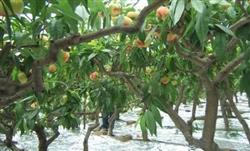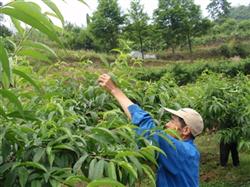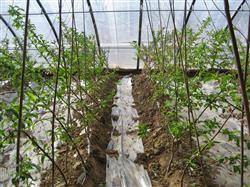How to manage peach trees after fruit picking?

How to manage peach trees after fruit picking? Please introduce facilities peach trees can be managed with reference to the following methods after fruit harvest: first, pruning after harvest. 1. Pruning after opening the shed. The fruits of protected peach trees can generally be harvested in mid-late May. After uncovering the shed, peach trees continue to grow and carry out flower bud differentiation. It is worth noting that the shoot formed in the greenhouse can not carry out normal flower bud differentiation, only the new shoot formed after opening the greenhouse can carry out flower bud differentiation and flower bud gestation. Therefore, after uncovering the shed, the top section formed in the shed must be pruned, the new fruiting mother branches should be cultivated, the disease and insect branches and long branches should be cut off immediately, the extended new shoots of backbone branches should be cut moderately, and the rest of the new shoots should be heavily truncated to promote the development of auxiliary shoot-shaped fruiting branches. 2. Summer pruning. Early June and mid-August are the period of exuberant growth and flower bud differentiation of peach trees. Pruning in this period should first be carried out when the new shoots are about 30 cm long, with a total of 2 or 3 times; the second is to remove over-dense branches and twist the upright shoots with space; the third is to pull branches, especially the trees planted in the first year, whose purpose is to create good ventilation and light transmission conditions to control prosperous growth and facilitate the formation of flower buds. 3. Pruning during dormancy. The trees were pruned during the dormant period in the middle of November. In this period, the method of combining short cutting and thinning branches is adopted, the trunk extension branches are generally cut to 30cm and 40cm, the bouquet-like fruit branches are sparse but not cut, the dense growing fruit branches should be straight and oblique, and the branch group should pay attention to renewal and rejuvenation so as to keep the branch group moderate and healthy. Second, postharvest soil fertilizer and water management 1. Foliar fertilizer spraying. The formula is 0.3% urea + 0.3% potassium dihydrogen phosphate + 0.2% photosynthetic micronutrient fertilizer, which is designed to increase the assimilation function of leaves, increase tree nutritional storage, promote flower bud differentiation and improve flower bud quality. 2. Irrigation and drainage. Peach trees are drought-tolerant and afraid of waterlogging. After uncovering the shed, they should be drained in time after natural rainfall to prevent the occurrence of waterlogging. However, when the soil is too dry, we should pay attention to light irrigation to ensure a certain amount of soil moisture. 3. Ploughing and weeding. After each irrigation, it is necessary to loosen the soil and preserve soil moisture and remove weeds from the tree plate, so as to increase soil permeability, activate root physiological function and promote root growth. Third, postharvest pest control 1. Disease. The main diseases of peach trees in greenhouse are bacterial perforation, brown spot perforation, downy mildew and so on, but they are much lighter than those cultivated in the open air. Conventional germicidal drugs such as Dysen zinc, methyl thiophanate and carbendazim can be used alternately, and the concentration is generally 600 to 800 times. 2. Insect pests. The occurrence of peach aphid, powdery aphid and tumor aphid is more common and serious, which can be controlled by pyrethroids, such as Kuailing, Wanling, Kuishaling and enemy killing, and the use of organophosphorus pesticides is strictly prohibited. 3. Mites. It rarely occurs in the greenhouse and occurs in a large number after the film is uncovered. It can be controlled by drugs such as Saomijing and Nisolang, and the concentration is generally 1000-2000 times. Click to get more peach tree planting techniques click to get more fruit planting techniques
- Prev

How to prune peach trees after picking fruit?
How to prune peach trees after picking fruit? Please give guidance after picking peach trees can refer to the following methods for pruning: ① for the initial fruit trees, the backbone branch angle is small, to pull the branch opening angle; new and growing branches, when growing to about 30 cm, to be coring. ② to over-dense branches, thin branches, drooping branches.
- Next

How to manage planting peach trees in greenhouse?
How to manage planting peach trees in greenhouse? Please introduce the management of planting peach trees in greenhouse with reference to the following methods: first, anti-sprouting and pruning. Greenhouse peach tree sprouting period, timely removal of unreasonable sprouting. After flowering, the dense branches, overgrown branches, erect branches, shadow branches and cross branches should be removed in time according to the situation. Retracted 4-6 weeks before harvest.
Related
- Moge, come on! The staff of the peasant association in the producing area of cantaloupe were frightened when the crowd gathered.
- Causes and Solutions of low Fruit setting rate of Apple
- Symptoms and control measures of passion fruit virus disease
- Fruit growing lesson: how do apple orchards keep high yields?
- Can you build orchards in the mountains? What are the pros and cons?
- How to manage the coloring period of Crisson grape?
- This paper introduces the processing technology of two kinds of fig products.
- How much is a month for retired teachers in rural areas by 2020?
- How can strawberry planting increase sugar content? We should pay attention to management in many aspects.
- What are the cultivation techniques on how to improve the yield of golden fruit?

